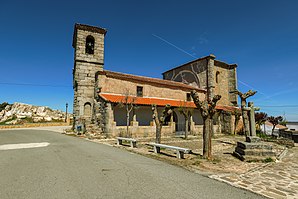Guijo de Ávila
| Puente del Congosto municipality | ||
|---|---|---|
 Guijo de Ávila - Iglesia de Santiago Apóstol
|
||
| coat of arms | Map of Spain | |

|
|
|
| Basic data | ||
| Autonomous Community : | Castile and Leon | |
| Province : | Salamanca | |
| Comarca : | Alto Tormes | |
| Coordinates | 40 ° 32 ′ N , 5 ° 38 ′ W | |
| Height : | 950 msnm | |
| Area : | 13.46 km² | |
| Residents : | 76 (Jan. 1, 2019) | |
| Population density : | 5.65 inhabitants / km² | |
| Postal code : | 37774 | |
| Municipality number ( INE ): | 37155 | |
| administration | ||
| Website : | Guijo de Ávila | |
Guijo de Ávila is a place and a western Spanish municipality ( municipio ) with only 76 inhabitants (as of January 1, 2019) in the province of Salamanca in the autonomous region of Castile-León .
location
The place Guijo de Ávila is about 500 m from the middle course of the Río Tormes at an altitude of about 950 m ; the provincial capital Salamanca is about 60 km (driving distance) north. The climate in winter is cool, but in summer it is quite warm; the rather low amounts of precipitation (approx. 480 mm / year) fall - with the exception of the almost rainless summer months - distributed over the whole year.
Population development
| year | 1857 | 1900 | 1950 | 2000 | 2016 |
| Residents | 508 | 670 | 422 | 115 | 68 |
The continuous decline in population since the middle of the 20th century is mainly due to the mechanization of agriculture and the abandonment of small farms and the associated loss of jobs.
economy
The economic life of Guijo de Ávila is largely agrarian - in the past, grain, vines, etc. were planted for self-sufficiency ; Vegetables came from the house gardens. Cattle breeding (in the past mainly sheep and goats, today mostly cattle) was and is still practiced. The small traders, craftsmen and service providers of all kinds that were formerly resident in the town have disappeared. Today numerous holiday apartments and houses (casas rurales) are rented out.
history
In the 8th century the Moors overran the region; However, nothing is known of a local foundation. In the 11th century the area was recaptured ( reconquista ) and repopulated ( repoblación ) by the Christians . In the Middle Ages, the place was part of the Tierra de Ávila .
Attractions
The Iglesia de Santiago Apóstol was built in the 16th century; The nave and bell tower date from this period . A south porch (portico) was added later. The significantly higher apse supported by buttresses , however, shows a later date of origin. The nave vault is rather simple; on the other hand, the apse is spanned by a star vault. The late baroque main altar (retablo) with an equestrian figure by Santiago Matamoros deserves attention .
Web links
Individual evidence
- ↑ Cifras oficiales de población resultantes de la revisión del Padrón municipal a 1 de enero . Population statistics from the Instituto Nacional de Estadística (population update).
- ↑ Guijo de Ávila - Climate tables
- ^ Guijo de Ávila - Population development
- ↑ Guijo de Ávila - main altar of the church

